Home › Q&A
Best Way To Hold a Guitar Pick
Question by JT
(NJ)
This may seem like a stupid question, especially for someone who has been playing for more than twenty years!
Recently, I have come across some great players online (blues, bluegrass) who say that in changing the way they hold the pick, they have greatly improved their playing.
They describe holding the pick with their index finger curled directly paralleled under their thumb as opposed to the index finger crossing perpendicularly under their thumb.
When I try this new method the tone of the guitar is stronger/louder but the control of the depth of the pick within the strings is much harder to control, especially in trying to play a smooth rhythm.
I know this seems like a small detail and may be just a player's preference, but I am curious as to how important the correct application of this fundamental playing technique might be.
Any insight is very much appreciated!
Suggestions
This is absolutely NOT a stupid question, no matter how long you've been playing!
This way of holding the pick you mention (the "fist" method) is actually more common than you might think, especially with players who use heavier gauge picks.
Let's just recap on the three main ways of holding the pick (you probably already know these, JT, but it's worth covering for those who don't).
The most common, and what I feel is the best compromise between control and tone, is the method I show in the beginners section, where you make an elongated O shape with your thumb and index finger:
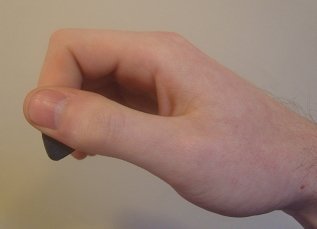
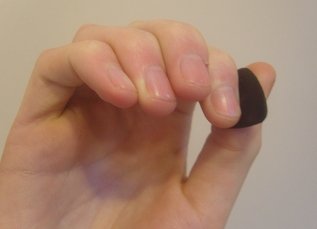
The second way is the "pinch" method, which offers greater pick flexibility. This uses the flat of your index finger rather than the side. I think this method is best for those who use soft/light gauge picks and spend most of their time strumming...
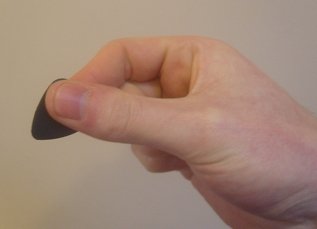
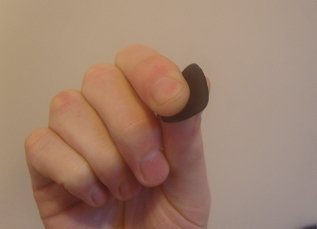
The third way, often called the "fist" method, I think tends to suit heavier gauge picks (often favoured by bluegrass players)...
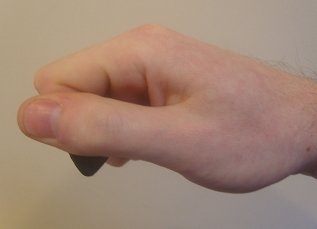
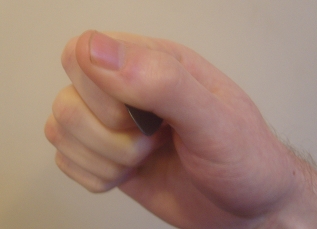
Obviously there are slight alterations of these 3 methods, such as how far the index is curled around. You mentioned the top part of the index finger being parallel with the thumb, so that's somewhere between the O method and the full fist.
It is, ultimately, personal preference.
So my first suggestion would be to experiment with different pick gauges, but while you're doing this, try the different holding methods, because they will work differently as combinations.
And these combos might change depending on the style of music you're playing.
When I played in a funk band, for example, I liked a light pick (less than 1mm gauge) and plenty of flexibility between my index finger and thumb for those 16th note strumming patterns (i.e. the smooth rhythm you mentioned). So I might not grip the pick so tightly to accommodate this flexibility.
But I'd also chop and change between a variety of different techniques (i.e. rhythm, lead), so the compromise of the "O" holding method worked well.
Over time, I've just got used to that compromise, and all my progress has been made using this one method (with pick gauges changing now and again for more focused playing, with recording for example).
That's a key point here - if years of progress has been made using one method, you may have to take quite a leap back if you switch to a new method. A fresh start is not always what you need.
"If it ain't broke...".
So in most cases, if you're beyond the beginner stage, it's best to spend very little time trying out different pick gauges and holding methods and just go with what you use now. You'll find and adapt your tone with any method you use, as your muscle memory develops, so try not to interrupt that important internalisation process.
You might go through short phases (as have I) where your curiosity gets the better of you and you revisit the pick gauge you use and even how you hold your pick. That's fine, but don't dwell on it, or change just because you see a great player using, or even recommending a particular method.
For every great guitarist who recommends one method, there will be another who swears by another method.
So, in summary, to get it "out of your system", I would get down to your local guitar shop, buy a range of pick gauges (if you haven't already), from very light (.38mm) to heavy (1mm +), and try out the three methods (including slight alterations) mentioned here over the next few days.
That's the only way you're going to know for certain which method feels the most natural to you.
Keep to your regular practice schedule and try playing songs and licks you already know using these different combos.
After a few days of experimentation, you should be able to eliminate those methods that simply aren't going to work for you and those which have potential.
If it's a close call between a few combos of pick gauge and/or holding method, I would personally just pick one and run with it.
Then, seriously, just forget about it and focus on your next playing goal!
Hope this helps.
Share Your Comments
|
||
|
||
|
||
|
||
|
||
|
||
|
||
|
||
|
||
|
||
|
||
|
||
|
||